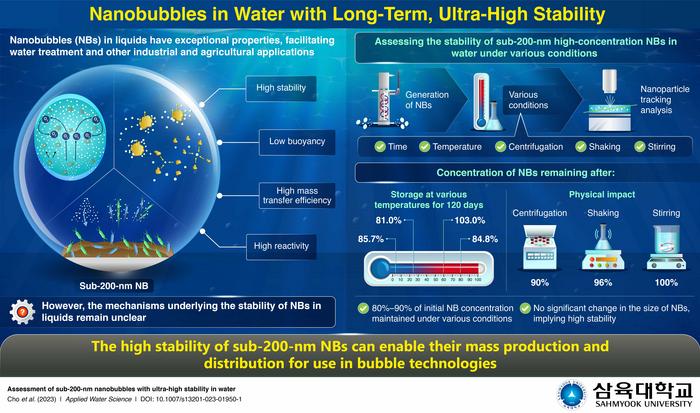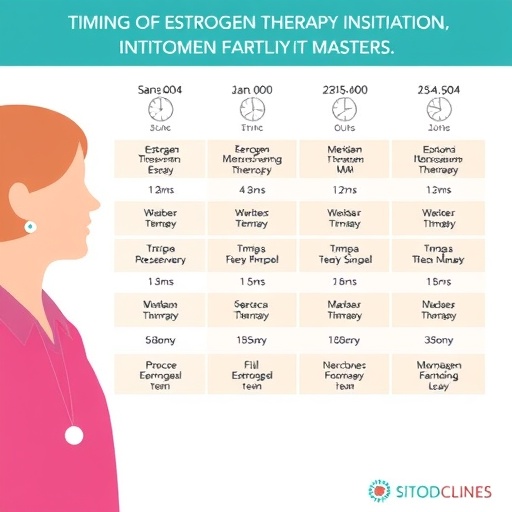Bubble technology has emerged as a powerful tool for addressing environmental pollution, enhancing water treatment processes, and boosting industrial and agricultural production. Such novel applications of this technology have emerged owing to the unique properties of nanobubbles (NBs)—gas bubbles smaller than 1,000 nanometers (nm) in diameter. In particular, NBs in water, especially those with diameter less than 200 nm, exhibit low buoyancy, high mass transfer efficiency, high reactivity, and exceptional stability. However, the underlying mechanism behind their stability has remained elusive, with most studies focusing only on the temporal changes in the size and surface charge of NBs and overlooking the changes in their concentration under various conditions.

Credit: Myoung‑Hwan Park from Sahmyook University, Korea
Bubble technology has emerged as a powerful tool for addressing environmental pollution, enhancing water treatment processes, and boosting industrial and agricultural production. Such novel applications of this technology have emerged owing to the unique properties of nanobubbles (NBs)—gas bubbles smaller than 1,000 nanometers (nm) in diameter. In particular, NBs in water, especially those with diameter less than 200 nm, exhibit low buoyancy, high mass transfer efficiency, high reactivity, and exceptional stability. However, the underlying mechanism behind their stability has remained elusive, with most studies focusing only on the temporal changes in the size and surface charge of NBs and overlooking the changes in their concentration under various conditions.
To address this issue, a team of researchers led by Associate Professor Myoung-Hwan Park from Sahmyook University in South Korea has recently investigated the number and stability of high-concentration NBs in water under various conditions. Their study was made available online on 09 June 2023 and published in Volume 13, Issue 7 of the journal Applied Water Science.
Highlighting the importance of NBs, Dr. Park remarks: “The most promising consequence of using NBs is that they can enhance the original performance of various components without any additional chemicals.”
The researchers first produced air NBs in water using a custom-made NB generator, with over two billion NBs per ml of water, each approximately 100 nm in size. They analyzed the stability of the NBs using nanoparticle tracking analysis, which involves shining a laser onto nanoscale particles suspended in a liquid and tracking their movements under a microscope. This technique enabled the researchers to investigate how the number and size of NBs change under different conditions, including storage at various temperatures and exposure to physical impacts like centrifugation, shaking, and stirring.
They found that the NBs retained 80–90% of their initial concentration under all the tested conditions. Specifically, when stored at 5oC, 25oC, 60oC, and 80oC for 120 days, the NBs maintained 85.7%, 81.0%, 103% and 84.8% of their initial concentration, respectively. In addition, when subjected to centrifugation for 90 minutes, the NBs maintained more than 90% of their initial concentration, and after eight hours of shaking, the corresponding value was 96%. Stirring the NB solution for eight hours did not change their concentration appreciably either. Moreover, the NBs exhibited no significant change in size in any of the above tests.
These findings indicate that sub-200-nm NBs exhibit remarkable stability under diverse conditions. “NBs show significant potential for real-life applications in mass production and distribution of bubble technology in various fields, such as pharmaceuticals, cosmetics, cleaning, environment, food, agriculture, and more,” highlights Dr. Park. “In addition, scientists are working towards reducing the reliance on harmful but indispensable chemicals, and the use of harmless gases and NBs can further support their efforts,” he concludes.
This study can thus open up new avenues for bubble technologies offering promising prospects for a safer environment and improved efficiency in water treatment, industry, agriculture, and beyond.
***
Reference
DOI: https://doi.org/10.1007/s13201-023-01950-1
About the Institute
Sahmyook University, the largest university owned by the Seventh-day Adventist Church, is situated in metropolitan Seoul, South Korea. The university is renowned for its pristine campus, earning the title of “Korea’s most beautiful university.” Its commitment to environmental sustainability is reflected in its eco-friendly construction. The university prides itself on its unique holistic academic counselling system in which students and professors organically work together in receiving and giving guidance. Comprising six colleges, including the College of Theology, Humanities & Social Science, and Health Science & Social Welfare, as well as four graduate schools, Sahmyook University provides a comprehensive educational experience.
Website: https://www.syu.ac.kr/eng/about-sahmyook/su-difference/
About the author
Myoung-Hwan Park is an Associate Professor of Chemistry and Life Science as well as the Director of the Research Center for NanoBioMaterials Lab at Sahmyook University. He obtained his Ph.D. in Chemistry from the University of Massachusetts at Amherst in 2012 and completed his Postdoctoral training at the Department of Chemical Engineering at MIT. His primary research focus lies in the development of innovative approaches and versatile materials for applications in drug delivery systems and industrial devices. He is also the founder and current CEO of NtoB Co. Ltd., a company dedicated to developing drug delivery platforms for brain cancer and cosmetics. Furthermore, he is also the founder and CEO of NBChem Co. Ltd., which specializes in manufacturing low-friction coating composites for mobile machines.
Journal
Applied Water Science
DOI
10.1007/s13201-023-01950-1
Method of Research
Experimental study
Subject of Research
Not applicable
Article Title
Assessment of sub 200 nm nanobubbles with ultra high stability in water
Article Publication Date
9-Jun-2023
COI Statement
The authors declare that there are no competing
interests




